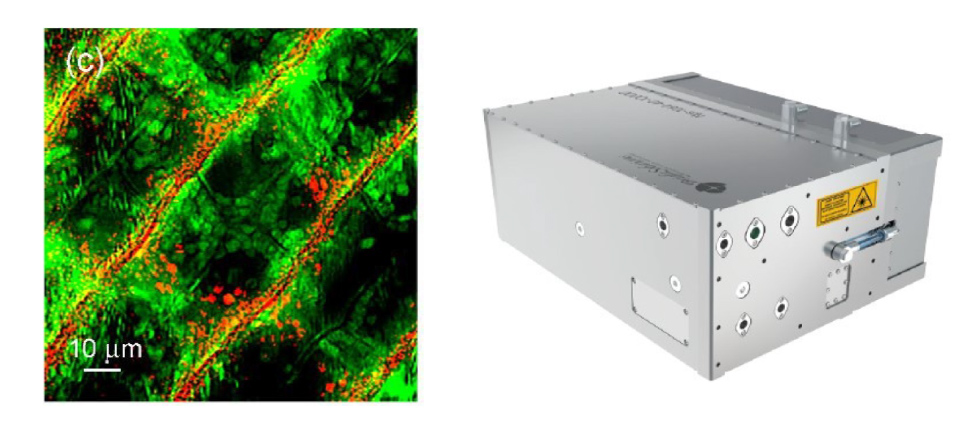NPS-T-800-1500: from the NEWMED project, a new ultrafast tunable laser for nonlinear spectroscopy and imaging
Modelling of complex systems like biological tissues, molecules interactions and many other phenomena are nowadays of big interest: imaging in live cells, tissues, and organisms is crucial for studies in medicine and biology because it enligthens the functional and structural status of biomolecules inside the living biological system. Methods meant for chemical and biological species identification and concentration measurement, such as Spectroscopy, based on the detection of emission spectra when properly irradiated by a light source, are in continuous progress. This is in thanks to the continually increasing investment in research funding for medical, pharmaceutical and pollutant imaging and monitoring. In particular, Raman spectroscopy is a growing technological sector: Raman-based processes reveal vibrational states without having limitations such as unwanted photo toxicity and fluorescent probes. Raman has certain advantages in both the label-free imaging and probed imaging of small biomolecules, with respect to spontaeus Raman scattering. Coherent Raman Scattering (CRS), which include Stimulated Raman scattering (SRS) and both CARS (Coherent Anti-Stokes Raman Scattering), are showing additional benefits.
SRS microscopy has emerged in the last decade as a powerful optical imaging technology with high chemical selectivity, speed, and subcellular resolution. Applications of SRS in research and the clinic have generated new insights in many fields including neurobiology, tumor biology, developmental biology, metabolomics, pharmacokinetics, and more. SRS imaging can be obtained by using two narrowband picosecond lasers that provide high speed vibrational imaging of a single Raman band at video rate (single-frequency SRS microscopy). It is commonly used to image known components in samples.
Raman spectroscopy like CARS and SRS require multiple laser wavelengths in order to operate. In most cases a narrow spectral laser operation (<6 cm-1) is an advantage with respect to femtosecond sources. The detection of specific stoke (or Anti-stokes) shifts is possible only with a limited bandwith. A transform limited picosecond pulse train represent the best trade-off for the application.
In order to meet the requirement of this microscopy field, Bright Solutions proposes the NPS-T-800-1500, a novel tunable ultrafast laser with narrow-bandwidth emission as candidate tool for Stimulated Raman Spectroscopy. This laser source has been developed within the FESR 2014-2020 program, with the Support of Regione Lombardia, Call Hub Ricerca e Innovazione, in a project named NEWMED. Offering a proper combination of optical properties, the NPS-T-800-1500, is a widely tunable ultrafast laser using an optical parametric oscillator (OPO), with high spectral purity and extremely narrow bandwith, delivering high intensity ultrafast pulses in several wavelength regions, and providing a unique solution in the field of laser spectroscopy and imaging.
This picosecond laser (T< 8 ps) provides four simultaneous outputs with high repetition rate (typ 40 MHz), high output power, short pulse duration, and narrow linewidth, making it the ultimate source for nonlinear microscopy. Two outputs are independently tunable in the 750 – 950 nm and 1200 – 1800 nm ranges, while the third and fourth are fixed at 1064 nm and 532 nm. The four simultaneous outputs enable advanced CARS and SRS applications with dual-band imaging, a broader selection of vibrational resonance frequencies and more.
The laser outputs are near Fourier Limited, enabling targeting of the desired vibrational transitions depending on the chemical compound. Optical bandwidths are narrower than 0.3 nm. The output laser beams are Near diffraction limited, having high beam quality M2<1,2 enabling a small spot on samples. Moreover, the pump laser and the tunable non-linear downconverter are hosted in a compact monolithic case, a “all-in-one-box”, enabling a rugged solution for integration in both microscopy systems and laboratories. The first prototype of this laser concept has been developed within the NEWMED project, belonging to the OPEN INNOVATION Plaftorm https://www.linkedin.com/company/open-innovation-lombardia/.
Illustrated below is the compact and rugged NPS-T-800-1500 developed by Bright Solutions within the NEWMED Project.

